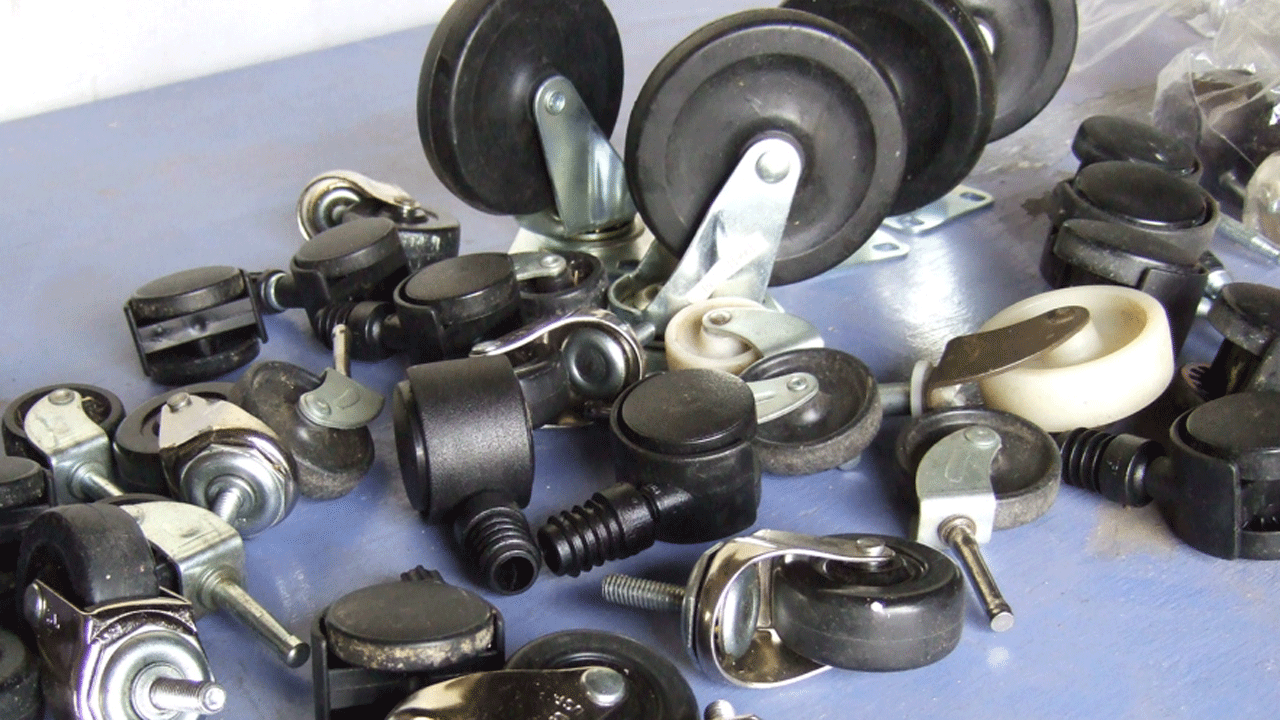1. Put wheels on classroom furniture.
Spaces need to be flexible to accommodate a wide variety of student-use scenarios and project-driven set ups. Furniture that can be easily rolled out of the way can go from collaboration lounge to prototype lab with little effort. A variety of casters can be found at IKEA or your local hardware store. Use casters with stems for desks and tables. These have sleeves that can be inserted into the legs. Plate mounted casters can be screwed directly into the base of the furniture. Look for wheels that swivel in all directions so that students can move them easily. Many casters have locks which help to keep them from moving once you’ve got them in place.
2. Create comfortable and customizable “break-out spaces” with couches or soft chairs where students can work together.
Stanford University's “d.school” (design and engineering school), where the current design thinking trend was jump started, exemplifies the importance of comfortable collaboration spaces. d.school students draw from a mobile “kit of parts” to assemble work environments shaped to their project based activities and then put them all back afterwards. d.school has created a culture of creating the space for the environment you need. Furniture here easily rolls or stacks out of the way to leave an open room after the activity is finished. Working in this space requires presence of mind of how you will interact and how the space should be shaped to accommodate that.
3. Look for spaces on your campus that can be transformed into a student-driven collaboration classroom.
The Australian Science and Mathematics School, a public high school in Adelaide, repurposed a basement storeroom as their innovation “shed.” The shed supports 17 students in self-organized learning and tinkering on Thursday mornings and was designed to be a “funky” place teenagers would be comfortable perusing what they are interested in. Sivam Krish directs programs at the shed, but does not teach in the traditional sense. He encourages peer-to-peer learning in the space. The shed is furnished with cheap garage equipment and relatively inexpensive technology. Nothing is fixed: monitors, 3-D printers, computer workstations, and other equipment are mounted on wheeled scaffolding carts so that students can frequently adjust their space to suit their projects.
4. Create a shared design-thinking space for all students to use.
By being inclusive of all students, the program can serve as a compliment to the rest of the curriculum. At Marin Primary and Middle School in Northern California, the kindergarten through 8th grade classroom curriculum links to hands-on projects that kids do in the school’s “Projects Lab.” The lab is a locus where all the equipment that can facilitate student tinkering and prototyping is concentrated, with some inherent flexibility in its layout to accommodate student creativity.
In San Francisco, Lick-Wilmerding High School’s Design and Technology Center takes sharing a step further by bringing together many of the schools communal resources. The center houses teaching workspaces and shops for wood, metal, glass and electronics, as well as a multi-purpose room, computer lab, and two conference rooms. The central, single level, configuration of the spaces allows for a shared work area between disciplines and encourages student interaction and interdisciplinary collaboration.
5. Create a design-thinking space is a design-thinking exercise.
Assign students the task of designing the design-thinking environment. Groups of the students enrolled in the one-semester design-thinking course at Flint Hill School in Oakton, Virginia came up with blue-sky proposals for redesigning the school library. At the end of the semester, two 11th grade participants, Jack Morrissette and Zane Homsi, used an independent study credit to further consider how design thinking could be expanded at the school. Their study culminated in a more feasible library redesign based on the collective ideas from their classmates—including a proposal to free up space for design-thinking environments by going completely digital. With no more shelves full of hard copy books, there would be room for comfy chairs and moveable white board walls for collaboration spaces, and an innovation lab with 3-D printers, visual design technology and other tools. Their proposal is currently being considered by the school board.
6. Ask for help.
Ask students’ families and the community to donate gently used furniture, construction tools, sewing machines, fabric, wood remnants, and other tools and materials they no longer use. Power tools, an integral component of any decent maker-studio space, empower kids with confidence and the independence to prototype and test their ideas. Ask parent volunteers to demonstrate how to use them correctly and with the necessary safety equipment. Ask the PTA or your board to help raise the funds for your program.
You can also ask to visit design thinking programs other schools. The Willows Community School in Culver City, California visited Castilleja High School's Bourn Idea Lab in Palo Alto where parent and resident tinkerer, Diego Fonstad, showed the space and offered insights into how the school integrates the classroom learning and physical aspects of making into one project.
Rethinking learning environments will play an important role in education in the years to come. Are you rehashing old models or covering new ground? Everyone who cares deeply about education wants to find creative ways to engage the next generation of learners. The thinking about these spaces will continue to evolve and change as we try them out and learn from these experiences. This is the design-thinking process for creating the next generation of learning environments.
Let’s keep this conversation going. What ideas for bringing design thinking into schools have you tried?


